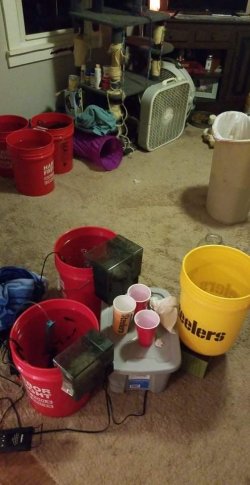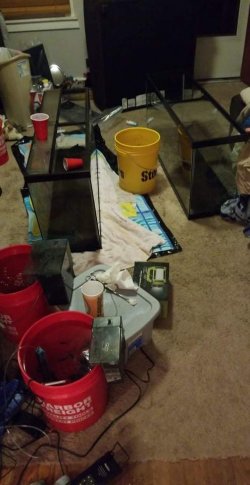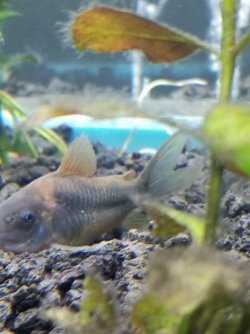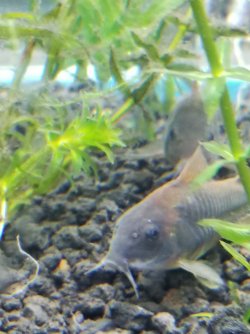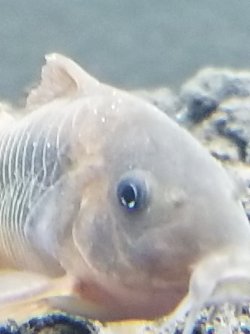IR_Crayoneater
New Member
So I coach football and got home from practice tonight, took a peek at my tank and realized I was missing about 10 gallons of water. I started checking the filters and everything to make sure nothing was leaking out of there and spotted a steady stream of water coming from the front/left underside of the tank. I monitored the water level for 10 minutes and realized I was losing about 1/16th of an inch every 10 minutes. I had no back up tank, luckily a friend of my nephews works at a fish store and hooked me up with a new 55 gallon tank after closing. I am 90% sure a seal busted because I cannot see any cracked glass, I bought this tank used 3 months ago to upgrade from a 30 to a 55gal.
I had 5, 5 gallon buckets that are strictly used for the fish tank only and get dried out and put in a sealed bag when not in use. So as soon as I got done picking up the tank I siphoned out 25 gallons of water into these buckets, set up a heater in 2 of them and my 55gal filter in one and 70gal filter in the other, placed all my mollies, snails and platys in one bucket then my loaches, corys and pleco in the other bucket. Dropped all my plants in a third bucket and let the drift wood sit out on paper towels on the counter.
My wife cleaned out the new tank with a solution of white vinegar and water, dried it, then straight clean tap water and dried it again till the smell of vinegar was gone. I drained the rest of the water and previously I had 4" of gravel in the tank that was leaking, I only removed 2" of gravel from it, mixed between the top and bottom layers and placed it into the new tank, mainly because I was preparing to switch from the Eco-Complete I have to sand after recommendations from a previous posting, plus I figured it will make the change quicker in the future and because I didnt want to leave all my fish in those buckets for an extended period of time while I tried to transfer all my gravel.
Once I got the 2" of gravel transferred, I stuck my airstone into the tank, I poured all the water from the two buckets with just straight old tank water into the tank, then started filling up those two with tap water, treating with prime and dumping it into the tank. I replanted everything, removed the heater from my bottom feeder bucket, turned it up to get the tank temperature adjusted quickly, removed the filter from that bucket and set it back up and then placed those fish back into the tank and dumped that water back in. I then took the other bucket, placed fish back into the tank, dumped the water into the tank, reset the filter back up ( I run a dual filter setup) and topped the tank off with new water.
In all I did probably a 60% "water change" from this. The first bucket I put 1 table spoon and half a teaspoon of aquarium salt in, I KNOW I KNOW its freshwater, but one of the fish got injured running from my net as I was getting them into the bucket so I took a precaution, its still well below recommended dosage. I then added 5 capfuls of quickstart which is 25ml, the recommended dosage for my tank. In total it took 3 hours from start to finish. I have been monitoring the fish for an hour and everyone "seems" ok right now. I decided not to feed them tonight in case of a crash or levels being off. I did not test the water yet because I want to let everything settle before hand.
In this entire process is there anything I should of done differently ? Is there anything I need to be watching for besides my tank crashing and sickness from stress ? Is there anything else I can do now to help my fish after this fiasco and prevent any deaths?
*Note* Yellow bucket in the picture I grabbed from my garage to siphon the rest of the water out and dump it outside, once I filled my 5 red ones up with the old tank water. The water in the yellow bucket was never dumped back into the tank.
I had 5, 5 gallon buckets that are strictly used for the fish tank only and get dried out and put in a sealed bag when not in use. So as soon as I got done picking up the tank I siphoned out 25 gallons of water into these buckets, set up a heater in 2 of them and my 55gal filter in one and 70gal filter in the other, placed all my mollies, snails and platys in one bucket then my loaches, corys and pleco in the other bucket. Dropped all my plants in a third bucket and let the drift wood sit out on paper towels on the counter.
My wife cleaned out the new tank with a solution of white vinegar and water, dried it, then straight clean tap water and dried it again till the smell of vinegar was gone. I drained the rest of the water and previously I had 4" of gravel in the tank that was leaking, I only removed 2" of gravel from it, mixed between the top and bottom layers and placed it into the new tank, mainly because I was preparing to switch from the Eco-Complete I have to sand after recommendations from a previous posting, plus I figured it will make the change quicker in the future and because I didnt want to leave all my fish in those buckets for an extended period of time while I tried to transfer all my gravel.
Once I got the 2" of gravel transferred, I stuck my airstone into the tank, I poured all the water from the two buckets with just straight old tank water into the tank, then started filling up those two with tap water, treating with prime and dumping it into the tank. I replanted everything, removed the heater from my bottom feeder bucket, turned it up to get the tank temperature adjusted quickly, removed the filter from that bucket and set it back up and then placed those fish back into the tank and dumped that water back in. I then took the other bucket, placed fish back into the tank, dumped the water into the tank, reset the filter back up ( I run a dual filter setup) and topped the tank off with new water.
In all I did probably a 60% "water change" from this. The first bucket I put 1 table spoon and half a teaspoon of aquarium salt in, I KNOW I KNOW its freshwater, but one of the fish got injured running from my net as I was getting them into the bucket so I took a precaution, its still well below recommended dosage. I then added 5 capfuls of quickstart which is 25ml, the recommended dosage for my tank. In total it took 3 hours from start to finish. I have been monitoring the fish for an hour and everyone "seems" ok right now. I decided not to feed them tonight in case of a crash or levels being off. I did not test the water yet because I want to let everything settle before hand.
In this entire process is there anything I should of done differently ? Is there anything I need to be watching for besides my tank crashing and sickness from stress ? Is there anything else I can do now to help my fish after this fiasco and prevent any deaths?
*Note* Yellow bucket in the picture I grabbed from my garage to siphon the rest of the water out and dump it outside, once I filled my 5 red ones up with the old tank water. The water in the yellow bucket was never dumped back into the tank.


